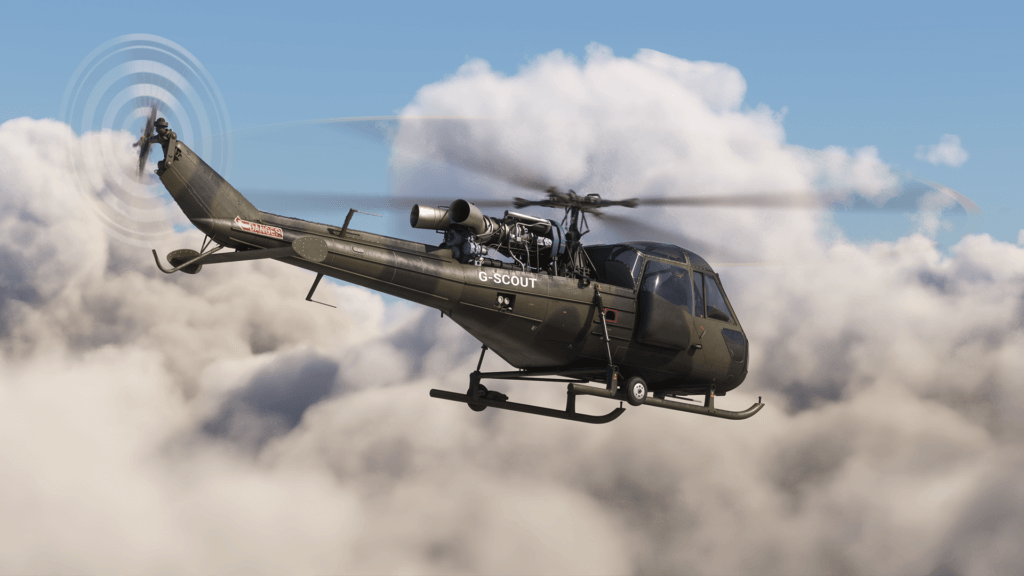Westland’s sibling military utility helicopters each left their mark in rotorcraft history.
Born of the P.531
The history of the Scout and Wasp began in November of 1957. British aerospace company Saunders-Roe undertook an initiative to develop a military utility helicopter as a successor to their earlier Skeeter model. The 2-seat, piston-powered Skeeter was the first helicopter widely used by the British Army Air Corps and proved highly successful. The replacement, a turbine-powered, 5-seat prototype helicopter called the P.531, used several components from the Skeeter for convenience but the later production variant would replace these items as part of its new design. The P.531 took its maiden flight on July 20, 1958.
When Westland Helicopters acquired Saunders-Roe in 1959 the intended production standard helicopter, the P.531-2 had already taken its maiden flight. Engineers then implemented a more powerful engine and replaced the wheeled undercarriage fitted to the P.531 with landing gear skids. The P.531-2, which took its maiden flight on August 9, 1959, would go on to form the basis for a light helicopter to equip frontline squadrons in both the
British Army Air Corps and the British Royal Navy. Westland developed the P.531-2 into the Scout for the Army and the Wasp for the Royal Navy.
The Westland Scout
The Westland Scout is a multi-role, land-based, military utility helicopter developed and manufactured by Westland Helicopters (now known as Leonardo) of the United Kingdom. Operated by one pilot, the single-engine Scout can carry up to four passengers. The rotorcraft took its maiden flight in August of 1959 as the Saunders-Roe P.531-2 and Westland Helicopters began deliveries to the Army Air Corps in 1963.
The Scout performed several roles during its military operational tenure. These included ISR (intelligence, surveillance, and reconnaissance) data collections, close air support, ground attack, assault support, casualty evacuation, forward observation, troop and cargo transport, search and rescue, and flight training. It was used by the British Army Air Corps among other operators.
The Scout features an extensively glazed cockpit, a powerful turboshaft engine, and an efficient 4-blade main rotor system. At the time of its development, it used the most advanced rotorcraft flight controls, avionics, and weapons control systems available. Its modular design allowed for a multitude of configurations, including casualty evacuation, troop transport, and the mounting of several weapon systems.
The combination of design elements made the Scout an incredibly effective military aerial platform. It could fly fast and low in nap-of-the-earth maneuvering, it could engage targets from long distances, and it could carry militarily useful loads of supplies and personnel. It could be re-armed and refueled within three minutes, and it could operate out of austere expeditionary bases. The Scout was a renowned workhorse for the Army Air Corps.
The Westland Scout measures 30 feet, 4 inches in length, stands 8 feet, 11 inches tall, and has a main rotor diameter of 32 feet, 3 inches. It is powered by a Rolls-Royce Nimbus turboshaft engine that delivers up to 685 horsepower. It has a range of 315 miles, a service ceiling of 12,000 feet above sea level, and it climbs at 1,670 feet per minute. It cruises at 122 miles per hour and has a top speed of 131 mph.
The Westland Wasp
The Westland Wasp is a sea-based, military multi-role helicopter with an emphasis on anti-submarine operations. It is derived from the Saunders-Roe P.531 and P.531-0N which were used to develop a suitable undercarriage design and to demonstrate the potential military benefit of embarking a small rotorcraft onto small anti-submarine warships. Wasp development was completed by Westland Helicopters (now known as Leonardo) of the United Kingdom following its acquisition of Saunders-Roe in 1959. The Wasp took its maiden flight on October 28, 1962 and it entered service in 1963.
During its operational tenure, the Wasp primarily served as a platform for delivering weapons to counter threats posed by submarines that were detected by specialized ship-based sensors. It also performed the roles of personnel transport, ISR (intelligence, surveillance, and reconnaissance) data collections, liaison, and casualty evacuation. Crewed by a single pilot, it could carry up to four passengers. When equipped with guided air-to- surface missiles, it was operated with a crew of two, pilot and weapon system controller. The Wasp was operated by the British Royal Navy and the navies of several other countries. The wasp was used as a military helicopter until 2000.
The Wasp features a fully glazed cockpit, an efficient 4-blade main rotor system that folds for stowage, and a folding tail boom for stowage. It uses a long-legged landing gear system with castering wheels for maneuvering on flight decks. The helicopter’s main rotor system can be set for negative pitch to press it against a flight deck. At the time of its development, it used the most advanced rotorcraft flight controls, avionics, and weapons control systems available.
The Westland Wasp measures 30 feet, 4 inches in length, stands 8 feet, 11 inches tall, and has a main rotor diameter of 32 feet, 3 inches. It is powered by a Rolls-Royce Nimbus turboshaft engine that delivers up to 710 horsepower. It has a range of 303 miles, a service ceiling of 12,000 feet above sea level, and it climbs at 1,440 feet per minute. It cruises at 110 miles per hour and has a top speed of 120 mph.
The Microsoft Flight Simulator Westland Scout & Wasp
The Microsoft Flight Simulator Westland Scout & Wasp is ready for operations throughout the MSFS world. Recreated in impeccable detail, each flight of either of these two rotorcraft will leave lasting memories.
It is available today from the Marketplace for USD $14.99. The sky is calling!
Microsoft Flight Simulator is available for Xbox Series X|S and PC with Xbox Game Pass, PC Game Pass, Windows, and Steam, and on Xbox One and supported mobile phones, tablets, and lower-spec PCs via Xbox Cloud Gaming. For the latest information on Microsoft Flight Simulator, stay tuned to @MSFSOfficial on X (formerly Twitter).

